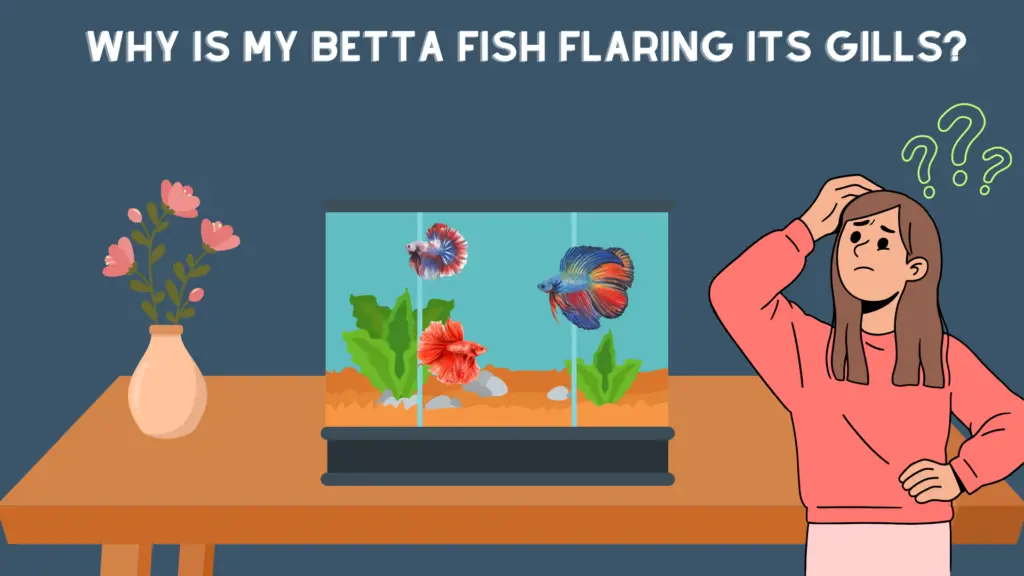Understanding Betta Fish Behavior
Betta fish, also known as Siamese fighting fish, are fascinating creatures known for their distinctive behaviors, prominently including the action of flaring their gills. This behavior, often observed in male bettas, involves the fish spreading its gill covers wide open to appear larger and more intimidating. While flaring is a natural behavior, understanding its underlying reasons and implications is crucial for ensuring the well-being of your pet.
Why is my Betta Fish flaring its gills?
Flaring is primarily a response to perceived threats or challenges in the environment. When a betta fish flares, it is displaying aggression and attempting to assert dominance. This behavior can be triggered by various factors, ranging from environmental conditions to specific behavioral stimuli.
Reasons for Flaring
Flaring in betta fish can be influenced by several factors, each playing a role in the fish’s response:
Environmental Factors
- Water Quality: Poor water quality, characterized by high levels of ammonia, nitrites, or fluctuating pH levels, can stress betta fish. Stress is a significant trigger for flaring behavior. Maintaining optimal water parameters through regular water changes and adequate filtration is essential to reduce stress and minimize flaring.
- Tank Size and Setup: Betta fish require adequate space to swim freely and explore their surroundings. In smaller tanks, bettas may feel confined, leading to stress and increased flaring. Providing a spacious tank with appropriate decorations, plants, and hiding spots can create a more stimulating environment and reduce stress-related behaviors.
- Tank Mates: The presence of other fish or tank mates can trigger flaring in bettas, especially if they are perceived as threats or rivals. Choosing compatible tank mates that do not resemble bettas in coloration or fin shape and ensuring each fish has ample space can help minimize aggression and reduce flaring incidents.
Health Issues
- Stress: Besides environmental stressors, other factors such as inadequate tank size, aggressive tank mates, or sudden changes in water conditions can contribute to stress in betta fish, leading to increased flaring. Addressing these stressors promptly is crucial to maintaining your betta’s health and well-being.
- Disease: Certain illnesses, such as fin rot or fungal infections, can cause discomfort and stress in betta fish, prompting them to flare as a response. Regular monitoring of your betta’s physical appearance and behavior can help detect signs of illness early, allowing for timely treatment and alleviating stress-related behaviors like flaring.
Behavioral Triggers
- Reflections: Betta fish are known to react to their reflections in the aquarium glass, mistaking them for rival fish. This can trigger territorial behavior and lead to persistent flaring. To minimize this, covering the sides of the tank with a background or providing distractions such as floating plants can reduce your betta’s response to its reflection.
- Intruders: The sight of another fish or even a human approaching the tank can also trigger flaring in bettas, as they perceive the presence of an intruder in their territory. Minimizing sudden movements and providing a consistent routine around the tank can help reduce stress-related flaring.
- Territorial Behavior: Betta fish, especially males, exhibit territorial behavior and may flare when they feel their territory is being encroached upon. This behavior is a natural instinct and can be managed by ensuring each betta has its designated space in the tank and reducing visual stimuli that might trigger aggression.
How to Address Flaring
Reducing flaring in betta fish involves creating a conducive environment that minimizes stress and promotes their natural behaviors:
- Optimizing Tank Conditions: Maintain stable water parameters, perform regular water changes, and provide adequate filtration to ensure optimal water quality.
- Reducing Stress: Identify and eliminate sources of stress such as aggressive tank mates, inadequate tank size, or sudden changes in the environment.
- Behavioral Enrichment: Enhance the tank environment with plants, decorations, and hiding spots to provide stimulation and reduce boredom, which can contribute to stress-related behaviors like flaring.
Conclusion
In conclusion, flaring is a natural behavior in betta fish, often triggered by environmental factors, health issues, or specific behavioral stimuli. Understanding the reasons behind flaring and taking proactive steps to address them can significantly contribute to the overall health and well-being of your betta fish. By creating a well-maintained tank environment, minimizing stressors, and providing behavioral enrichment, you can help your betta fish thrive and reduce instances of flaring behavior.
FAQs
- Why is my betta fish flaring at its reflection? Betta fish can mistake their reflections for rival fish, triggering their territorial behavior and leading to flaring. To reduce this behavior, consider covering the sides of the tank or providing distractions to prevent your betta from seeing its reflection.
- Will adding more decorations to my betta fish tank reduce flaring? Adding more decorations, plants, and hiding spots can create a more stimulating and secure environment for your betta fish, reducing stress and flaring behavior.
- Can betta fish flare at other fish in the tank? Yes, betta fish can flare at other fish, especially if they perceive them as threats or rivals. It’s essential to choose compatible tank mates and provide enough space to minimize aggression and flaring.
- How can I tell if my betta fish is stressed? Signs of stress in betta fish can include decreased appetite, lethargy, fin clamping, or changes in coloration. Regular observation of your betta’s behavior and appearance can help detect and address stress early on.
- Should I be concerned if my betta fish flares occasionally? Occasional flaring in betta fish is normal and often a sign of their natural behavior. However, if flaring becomes excessive or is accompanied by other signs of stress, it’s essential to investigate and address the underlying cause to ensure your betta’s well-being.




